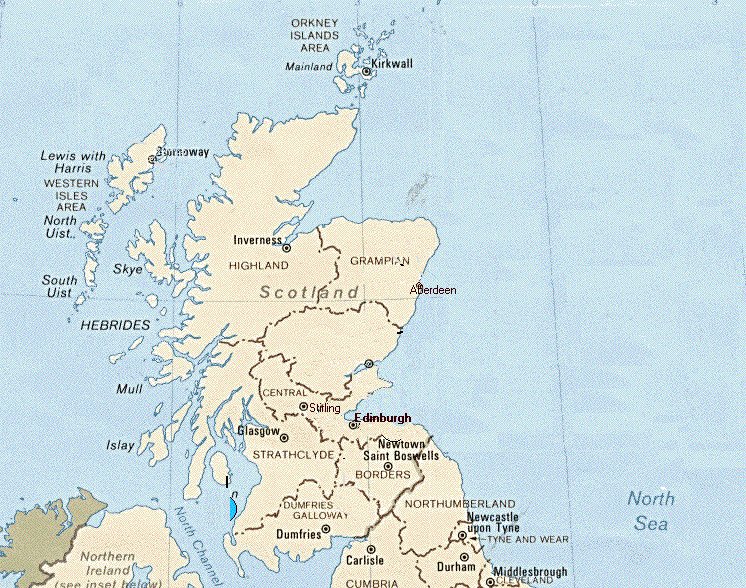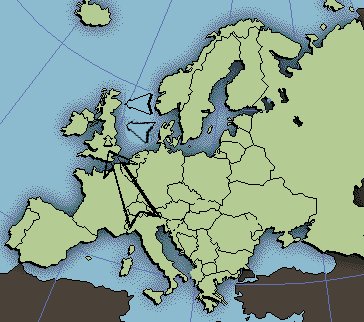
 Scotland:
The Ethnology and Geography
Scotland:
The Ethnology and Geography
This web page was created as a summer project for my Geography Teacher, Mr. Dittrich, at Chesterfield Day School.
Scotland is a country rich in history and culture. Like its neighbor England, Scotland has been a very influential nation in European history. In the United States there are many Scottish-Americans, most of them living in the South. One of the things Scots all over the world take pride in the most is their ethnic background. I will describe the Ancient Ethnology of Scotland. This is the backbone of the culture of Scotland.
In the second century A.D. the land of Scotland was divided into four kingdoms: Pictland (the Picts), Scotia (the Scots), the kingdom of the Britons, and Anglica (the Angles). Pictland, or the Kingdom of the Picts, was the largest and most powerful of the kingdoms. The Picts are believed to have been decedents of the earliest settlers of Scotland. The name Pict comes from the Latin word Picti, meaning "the painted ones." They got this name because, before going to war, the Picts painted pictures of animals on their bodies.
From the second century A.D. until 843 A.D., when they were conquered by the Scots, the Picts controlled the land North of the Firth of Forth. This land was split into two subkingdoms. The Southern subkingdom included Fife, Perth, and Angus. The Northern subkingdom contained the Highlands, the Western Isles, Moray, and Aberdeen. For these 600 years, the kingdoms of the Picts were free from conquering armies because of the mountainous terrain, long rain seasons, and harsh winters. Later, Norse raids reduced Pict strongholds in the North. The Norse could overcome the terrain and weather, because they sailed there instead of marching through the mountains. Also, since they came from Norway, they were used to similar terrain and weather.
To the Romans, the Picts were just pests, because they were the only tribe powerful enough to resist the Romans. Both Hadrian's Wall, and the later Antonine' s Wall, were built to keep the Picts out of Roman Britain and to some extent to keep the Romans from doing too much trading with the Picts. There were many wars between the Picts and the Romans, but they tended to occur in the less mountainous regions. Two of the biggest battles on Scottish soil before the four kingdoms were united were Mons Graupius and Trimontium. Even though they were both Roman victories, they marked the end of Roman control in Scotland.
The second largest kingdom belonged to the Scots. The Scots came from Northern Ireland and, for a short time, there was a kingdom that controlled parts of both Scotland and Ireland. It was easy for them to cross the North Channel because it was only a few miles between their homeland and the land that they sought to conquer. The Scots named the new land they migrated to Scotia, which was the Ancient name for Ireland. They also named their kingdom in Scotland Dalriada, which was the name of where they were from in Ireland. The Scots were more warlike than the Picts and later conquered them. When the Norse started attacking coastal regions of Scotland, the Scots moved away from the coast, breaking their strong ties with Ireland.
The kingdom of the Britons was the third largest. It contained modern day Strathclyde and Cumbria. Britannia, the Latin word for England and Scotland, derived from the Gaelic name the Britons gave themselves. The Britons came from the same Celtic ethnic family that the Scots did. They both spoke similar languages.
The smallest, yet most warlike, kingdom was that of the Angles. The Angles had been invited by the Romans to come to Britain as mercenaries. They came together across the Channel to the easily-conquered, flat regions of central England. Many Angles left their homes in modern day Germany expecting to find a better life in Britain.
By 685 A.D. all four kingdoms had been converted to Christianity. This was important in uniting the four kingdoms. The Angles continued to attack the other kingdoms. Finally, in 768 A.D. an army of Scots and Picts massacred the Angle army. That battle forced the Angles to unite with the Britons for protection. In 1018 the Kingdoms were united.
About 10 years before the Romans left Britain, the Vikings (Norse) crossed the North Sea and arrived in Sutherland and Caithness (Northern Scotland). For a while, the Norse did not bother the Picts or Scots, but soon the Vikings claimed and conquered Sutherland, Caithness, the Orkneys, and the Shetlands. These areas of Scotland were probably settled because they are very close to Norway, and because they were remote from other parts of Scotland. From their settlements in Scotland, the Vikings were able to raid the Western Isles, the Scottish Coast, and most importantly Ireland. The settlements in the Western (Hebrides and Lewis) and Northern (Shetland and Orkneys) were also useful because they could be used as stopping points between Scandinavia and Greenland and Iceland. In the late 14th century, the Vikings left mainland Scotland, the Western Isles, and the Orkneys. They would occupy the Shetlands until 1436. Norse culture was still very strong in the Highlands because the English and the Scottish Lowlanders didn't venture through the high mountains. Today, the Shetlands still have a noticeable Scandinavian culture.
Scotland was its own country until 1286 when King
Edward I of England claimed the Scottish throne. For the next twenty years
the Scots (this included the Picts, Scots, Angles, and Britons) fought
a bloody war for independence, ending in the establishment of a new Scottish
Kingdom. Not only did the victory over the English raise their spirits,
it also made the Scots proud of their roots, going back all of the way
back to the four kingdoms.


URL: http://www.umsl.edu/~sauter/Mike/scotland.html
Page Owner: Mike Martinich-Sauter
Last Updated: September 1, 1998